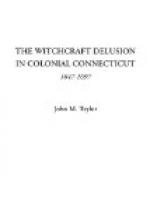“Or 2 if ye pty hath entertained a familiar spt in any forme mouse cat or othr visible creature.
“Or 3 if they affirm upon oath ye pty hath done any accon or work wch inferreth a ct wth ye devill, as to shew ye face of a man in a glass, or used inchantmts or such feates, divineing of things to come, raising tempests, or causing ye forme of a dead man to appeare or ye like it sufficiently pves a witch.
“But altho those are difficult things to prove yet yr are wayes to come to ye knowledg of y, for tis usuall wth Satan to pmise anything till ye league be ratified, & then he nothing ye discovery of y, for wtever witches intend the devill intends nothing but theire utter confusion, therefore in ye just judgmt of God it soe oft falls out yt some witches shall by confession discour ys, or by true testimonies be convicted.
“And ye reasons why ye devill would discover y is 1 his malice towards all men 2 his insatiable desire to have ye witches not sure enough of y till yn.
“And ye authors warne jurors, &c not to condemne suspected psons on bare prsumtions wthout good & sufficient proofes.
“But if convicted of yt horrid crime to be put to death, for God hath said thou shalt not suffer a witch to live.”
The accuser and the prosecutor were aided in their work in a peculiar way. It was the theory and belief that every witch was marked—very privately marked—by the Devil, and the marks could only be discovered by a personal examination. And thus there came into the service of the courts a servant known as a “searcher,” usually a woman, as most of the unfortunates who were accused were women.
The location and identification of the witch marks involved revolting details, some of the reports being unprintable. It is, however, indispensable to a right understanding of the delusion and the popular opinions which made it possible, that these incidents, abhorrent and nauseating as they are, be given within proper limitations to meet inquiry—not curiosity—and because they may be noted in various records.
A standard authority in legal procedure in England, recognized in witchcraft prosecutions in the New England colonies, was Dalton’s Country Justice, first published in 1619 in England, and in its last edition in 1746.
In its chapter on Witchcraft are these directions as to the witch marks:
“These witches have ordinarily a familiar, or spirit which appeareth to them, sometimes in one shape and sometimes in another; as in the shape of a man, woman, boy, dog, cat, foal, hare, rat, toad, etc. And to these their spirits, they give names, and they meet together to christen them (as they speak).... And besides their sucking the Devil leaveth other marks upon their body, sometimes like a blue or red spot, like a flea-biting, sometimes the flesh sunk in and hollow. And these Devil’s marks be insensible, and being pricked will not bleed, and be often in their secretest parts, and therefore require diligent and careful search. These first two are main points to discover and convict those witches.”




